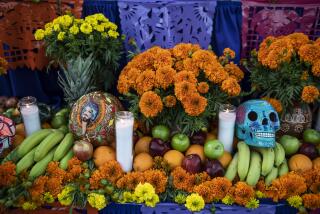Celebrating in Cebu
CEBU CITY, Philippines — I was here in January, an auspicious time for a visit to the Philippines, with the exchange rate heavily in the foreigner’s favor and a welcome social stability in marked contrast to the anguish and violence racking the country’s southern neighbor, Indonesia. On my first trip here several months before, I was reminded of Indonesia, also a former colonial nation of islands under long-standing authoritarian rule, yet the Philippines is very different.
The Dutch were content to limit their power in Indonesia to commerce and governance. The Spaniards didn’t stop at claiming the archipelago they discovered and named for the future King Philip II; they also felt compelled to baptize its inhabitants. This conversion of the Philippines to Roman Catholicism is responsible in no small part for the nation’s reputation today as the least Asian of Asian countries.
As my flight approached Manila’s airport, I thought of the time I lived in Mexico, and I tried to imagine a Latin American country superimposed on a Far Eastern one. My first visit to the Philippines had been confined mainly to Manila’s haphazard, fetid but vibrant urban sprawl, and it ended too soon. Even this time, I could manage only a long weekend after completing business in Palau, about 500 miles to the east. But I wanted to see something more of this country of 7,000 islands and 67 million people.
A friendly old hand suggested I see Cebu City and adjacent Mactan Island in the center of the archipelago, easily manageable in my allotted time.
My “source” was a former U.S. Marine Corps colleague I’d corresponded with but hadn’t seen in more than 30 years. He’d retired from the corps and returned to Cebu with his family. I was happy for the chance to see him in his homeland; that my visit would coincide with the annual festival in honor of the Christ Child--Pasundayag sa Sinulog--was all to the better.
Once aground, I sensed that this was an exciting time to be in the Philippines. The nation had just celebrated the centennial of its independence from Spain after four centuries of colonialism. A new president, Joseph Estrada, had been elected. And an unseasonable storm was gathering on the horizon. I was thinking that the air smelled of possibility crossed with a tincture of natural menace when, ahead of me, I recognized my old friend, Basco Consigio, and 30 years lifted like a theater curtain.
Though it is no secret that Americans and Filipinos fought side by side against the Japanese during World War II, it is less known that many Filipinos have served with distinction in U.S. forces. Basco, a career Marine, was one of them, and we served together. After three decades, he was his same short, wiry self, now with a few white hairs salting his pepper-black crew cut. We embraced, and he greeted me with my code name, “Iron Hand Charlie.” Then he presented me with a walking stick he’d carved himself, similar to one he’d given me years before, when we were both limping on bum legs.
Basco had been in Manila on business. Claiming my luggage, we rehashed old times with the urgency of men with a lot to cover in little time, and boarded a one-hour flight to Cebu’s Mactan International Airport on Mactan Island.
Despite the storm warnings, the weather held and the flight was smooth.
Cebu City is the country’s second largest metropolis and a major port. Mactan Island sits just offshore, connected by causeway and bridge. Founded by explorer Ferdinand Magellan in 1521, Cebu is also the oldest colonized city in the Philippines and the cradle of Christianity in the Far East. This history is venerated in Magellan’s Cross, which he planted where Filipinos were first baptized. The relic was thought to possess supernatural powers, and believers chipped off pieces of it over the years. The fragments that remain are in a replica housed in a monument a block from Cebu’s waterfront in the heart of the city.
Basco dropped me off at the hotel I’d booked on Mactan Island, with plans to start our sightseeing the next day.
The Shangri-La is a luxurious tropical oasis with a private beach on a ribbon of emerald sea not 20 minutes from the airport.
I rose early the next morning, Sinulog Sunday, in anticipation of the Pasundayag festival, and after laps in the pool and a dip in the ocean, I found Basco waiting for me in the lobby. We drove across the high span of the bridge, freighters passing beneath us, into Cebu City, with its rebounding economy and the obvious growing pains of a city on the move. Despite Asia’s stagnating economy, the go-getting Cebuanas applaud the mushrooming of hotel-casino complexes and the cash such places bring in from foreigners, especially Hong Kong and Taiwan Chinese.
“Ceboom,” as the locals call it these days, is also an industrial and commercial center, and it’s still a sailor’s town, with all that that implies.
We stopped for a beer at the Kentucky Bar uptown and listened to 1950s hits. It’s one of the places popular with retired American ex-pats as well as a sailors’ hangout when the fleet’s in.
But Basco was intent on showing me not just Ceboom, with its pollution, rolling dice, traffic jams, funky bars and pickpockets--and there was plenty of all that to see--but the city’s other face as well: the old town of colonial avenues and vestigial ruins.
After an early lunch in a Basque restaurant, where we lingered over squid and grilled lamb and Spanish wine, we had coffee in a cafe in an old colonial house. We were near the center of the festivities, and the sounds, both sacred and profane, echoed through the narrow streets. “Already a week old, day and night,” said Basco, reading my mind. “Festivals are our way of life.”
And so it was. By early afternoon we were making our way through the anticipant crowds past Ft. San Pedro, the nation’s oldest fortress (1565), to the front of the Basilica Minore del Santo Nino (1740). Inside the hushed, near-surreal, candle-lighted basilica, a chapel houses the Santo Nino, a statue of the Child Jesus. Magellan had brought the bejeweled, doll-size statue clad in red and gold robes from Spain, and he gave it to Queen Juana on the occasion of her baptism in 1521.
Outside the shrine, at the intersection of Magallanes and Burgos streets, horses pawed the cobblestones, occasionally neighing over the impatient din as the festival’s procession was set to begin. It led with a troupe of elderly women performing highly stylized arabesques to an atonal cacophony of percussion music, which echoed off the sun-bleached buildings. We were swept along with the costumed throng, men and women, some with faces blackened, others whitened, and dressed in full battle array of a pre-Hispanic day, with feathery head-to-toe smocks decorated with painted bulls and writhing snakes, and similarly painted headdresses and shields.
The cavalcade moved and swayed, steady and meandering as a river’s current, turning this corner and that and chanting “Pit Senor” (“long live the Lord”). The writhing, bedizened crowd bore an eerie resemblance to similar processions in Montezuma’s Mexico, as recorded by the eyewitness Bernal Diaz. Then I realized that trade between Acapulco and Manila was a routine commerce four centuries ago, and that cross-fertilization was sewn into the historical fabric of the New World and these islands.
Mactan Island is where the “Great Navigator,” as history knows Magellan, was slain in 1521 by rebellious islanders led by Lapu-Lapu. The spot where Magellan met his death is marked today by a modest monument. Nearby, in the grassy middle of a traffic circle, is a heroic statue of Lapu-Lapu.
That Sunday, just before evening, Basco and I set out under gathering rain clouds to walk the quarter-mile from the hotel to the monuments. It was a narrow, potholed road, lined with bamboo hovels and the occasional food stall, a marked contrast to the Shangri-La’s immaculate grounds, where well-heeled weekenders from Asia’s cities sought refuge in this sylvan retreat a world away from the squalor beyond the walls. Basco had to keep waving off the hawkers following us in motorized becaks, offering women and booze.
Later, at the hotel, Basco and I shared a seafood buffet with a table of gregarious Australians. One of them said the locals reenact Magellan’s death in battle on the anniversary every April 27. As the evening wore on, Basco told us that such a performance was but a shadow of another reenactment, a test of faith perhaps unique in the world: In a rice field outside Manila on Good Friday, one can witness several penitents being nailed to wooden crosses atop a makeshift Calvary in emulation of Christ’s Passion.
The next morning when I checked out of the Shangri-La to start my journey home, the weather was calm. Basco, driving me to the airport, expressed doubt it would be the same on Manila’s island of Luzon.
I learned in mid-flight, after the bucking aircraft free-fell 300 feet, that the storm predicted earlier was striking the capital head-on, flooding the city and closing the airport--and sending a cabin-load of shaken and shrieking passengers back to Mactan. Basco greeted me once again, this time shaking his head. “Why you don’t pack a crucifix instead of a church key?” he said with a straight face.
Oddly gratified by the delay, I rode out my final night in a closet-size cabin of the Philippine Dream Hotel, a floating casino where in the salon roulette wheels and slot machines sounded the hour while anxious travelers bawled their frustrations over the unaccommodating weather into their cellular telephones. But I was still high from Sinulog Sunday and, lifting a glass with Basco to toast a reprieve, found myself dreading the return to chaotic Manila and the long flight back across the Pacific Ocean.
(BEGIN TEXT OF INFOBOX / INFOGRAPHIC)
GUIDEBOOK
Seeing Cebu
Getting there: Northwest and Philippine Air Lines (PAL) fly from LAX to Manila with one stop; round-trip fares start at $705. PAL flies from Manila to Cebu City (Mactan) for $103 round trip.
Where to stay: The Shangri-La Mactan Island Resort, telephone 011-63-32-231-0288, fax 011-63-32-231-1688, charges from $180 for a double room and from $330 for suites. The Cebu Plaza Hotel, tel. 011-63-32-231-1231, fax 011-63-32-231-2071, is one of the top-rated hotels in Cebu City, with a pool, views and central location; doubles normally start at $135 but are as low as $52 in a promotion lasting through 1999.
Getting around: Leave valuables in your hotel safe, and keep your money secure on your person to discourage pickpockets and purse snatchers, particularly in festival crowds.
For more information: Philippine Department of Tourism, 3660 Wilshire Blvd., Suite 216, Los Angeles, CA 90010; tel. (213) 487-4525, fax (213) 386- 4063, Internet https://www .tourism.gov.ph.
More to Read
Sign up for Essential California
The most important California stories and recommendations in your inbox every morning.
You may occasionally receive promotional content from the Los Angeles Times.










